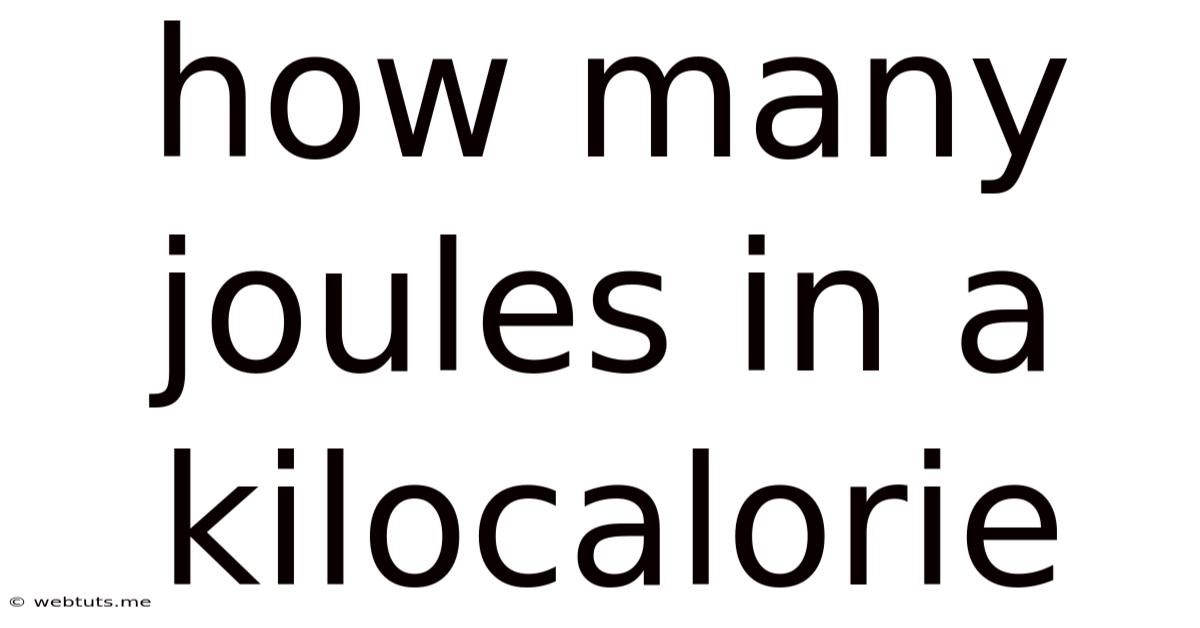How Many Joules In A Kilocalorie
Webtuts
May 12, 2025 · 4 min read

Table of Contents
How Many Joules in a Kilocalorie? A Deep Dive into Energy Units
Understanding energy units is crucial in various fields, from physics and engineering to nutrition and fitness. Often, we encounter kilocalories (kcal) in discussions about food energy, while joules (J) are the standard unit of energy in the International System of Units (SI). This article will thoroughly explore the relationship between joules and kilocalories, providing a comprehensive explanation with practical examples and addressing common misconceptions.
The Fundamental Difference: Defining Joules and Kilocalories
Before diving into the conversion, let's clearly define each unit:
Joules (J): The SI Unit of Energy
The joule, named after physicist James Prescott Joule, is the SI unit of energy. It represents the amount of work done when a force of one newton is applied over a distance of one meter. It's a versatile unit used to measure various forms of energy, including mechanical, thermal, electrical, and chemical energy. Its versatility makes it the preferred unit in scientific and engineering contexts.
Kilocalories (kcal): The Unit of Food Energy
The kilocalorie, often shortened to Calorie (with a capital "C"), is a unit of energy commonly used to quantify the energy content of food. One kilocalorie is equal to 1000 calories (lowercase "c"). A calorie is the amount of heat required to raise the temperature of one gram of water by one degree Celsius. While technically a unit of heat, it's widely used to represent the energy our bodies can obtain from food.
The Conversion Factor: Bridging the Gap Between Joules and Kilocalories
The key to understanding the relationship between joules and kilocalories lies in their conversion factor. One kilocalorie is equal to 4184 joules. This means:
- 1 kcal = 4184 J
- 1 Calorie = 4184 Joules
This conversion factor stems from the definition of the calorie and the mechanical equivalent of heat, which establishes the relationship between heat energy and mechanical work.
Practical Applications and Examples: Putting the Conversion to Work
Let's illustrate the practical application of this conversion with some real-world examples:
Example 1: Nutritional Labeling
A food label might state that a serving contains 200 Calories (kcal). Using our conversion factor, we can determine the energy content in joules:
200 kcal * 4184 J/kcal = 836,800 J
This demonstrates that the same energy content can be expressed in two different units.
Example 2: Exercise and Energy Expenditure
Suppose a person burns 300 kcal during a workout. To express this energy expenditure in joules:
300 kcal * 4184 J/kcal = 1,255,200 J
This illustrates the significant amount of energy involved in physical activity, highlighting the importance of understanding energy units in fitness and health contexts.
Example 3: Heating Systems
Consider a heating system that delivers 10,000 kJ (kilojoules) of heat energy. To convert this to kilocalories:
10,000 kJ = 10,000,000 J
10,000,000 J / 4184 J/kcal ≈ 2390 kcal
This conversion is essential in understanding the efficiency and energy consumption of heating systems.
Common Misconceptions and Clarifications
Several misconceptions surround joules and kilocalories. Let's address some common ones:
Misconception 1: Calories and kilocalories are interchangeable.
While often used interchangeably, especially in everyday language, it’s important to remember that a Calorie (with a capital C) is a kilocalorie (1000 calories). This distinction is crucial for accurate scientific and nutritional calculations.
Misconception 2: The conversion factor is always exactly 4184 J/kcal.
While 4184 J/kcal is the commonly used value, it's an approximation. The precise conversion factor depends on the specific conditions, particularly the temperature range over which the heat is transferred. However, this slight variation is generally negligible in most applications.
Misconception 3: All energy in food is easily converted to usable energy.
The kilocalories listed on food labels represent the total potential energy. However, our bodies don't efficiently convert all of this energy into usable energy. The actual amount of energy our bodies utilize depends on various factors, including metabolic rate, digestion efficiency, and the type of food consumed.
Beyond the Basics: Exploring Energy Transfer and Efficiency
Understanding the conversion between joules and kilocalories is just the first step. A deeper understanding requires exploring the concepts of energy transfer and efficiency:
Energy Transfer: Energy is constantly being transferred and transformed. For instance, the chemical energy in food is converted into mechanical energy during physical activity, and some energy is lost as heat. Understanding energy transfer pathways is critical in various fields, like thermodynamics and biochemistry.
Energy Efficiency: Not all energy conversions are 100% efficient. Some energy is always lost as heat or other forms of unusable energy. Understanding energy efficiency is crucial in optimizing processes and minimizing energy waste.
Conclusion: Mastering the Joule-Kilocalorie Conversion
The ability to convert between joules and kilocalories is essential for anyone working with energy calculations, whether in nutrition, physics, engineering, or other related fields. By understanding the fundamental difference between these units and applying the conversion factor correctly, you can accurately interpret and utilize energy data in various contexts. Remembering the key conversion factor, 1 kcal = 4184 J, and addressing the common misconceptions discussed will ensure accurate calculations and a deeper comprehension of energy principles. Furthermore, exploring concepts like energy transfer and efficiency will provide a more comprehensive understanding of energy dynamics in the world around us. Through consistent application and a nuanced understanding, mastery of this crucial conversion becomes achievable.
Latest Posts
Related Post
Thank you for visiting our website which covers about How Many Joules In A Kilocalorie . We hope the information provided has been useful to you. Feel free to contact us if you have any questions or need further assistance. See you next time and don't miss to bookmark.